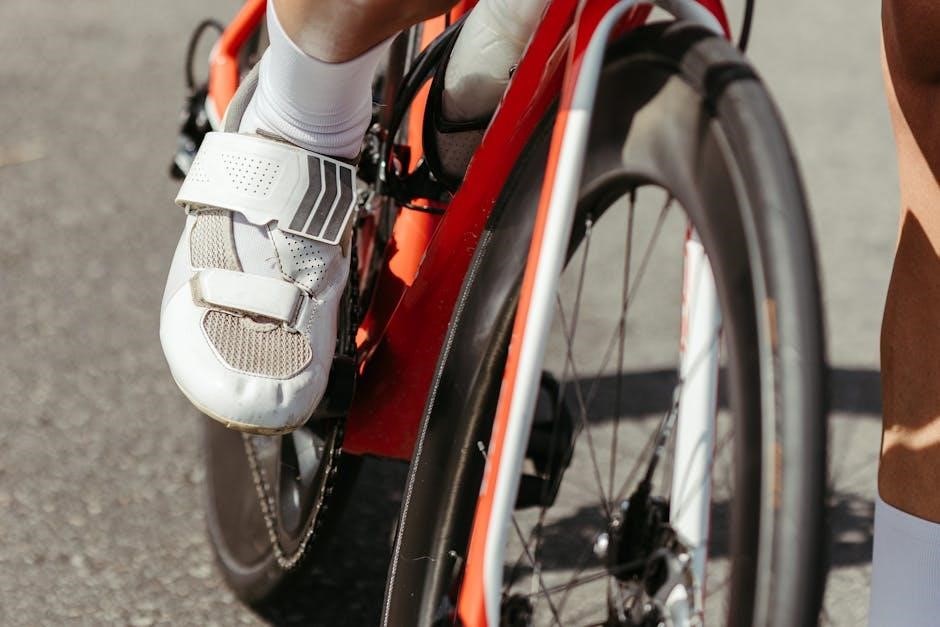A cycling training plan is a structured guide to help riders improve performance, endurance, and speed. Available as free PDFs, these plans cater to all skill levels, from beginners to experienced cyclists, offering customizable schedules and expert-designed workouts. Popular sources like Hincapie Sportswear and Cycling Weekly provide downloadable plans tailored for specific goals, such as Gran Fondo preparation or improving fitness. These plans typically include a mix of endurance rides, interval training, and strength exercises, ensuring a well-rounded approach to cycling development. Whether you’re aiming to complete your first century ride or enhance overall fitness, a cycling training plan serves as an essential roadmap to success.
1.1 What is a Cycling Training Plan?
A cycling training plan is a structured roadmap designed to help riders achieve specific cycling goals. Typically available as free PDFs, these plans outline daily, weekly, and monthly workouts tailored to skill levels. They include endurance rides, interval sessions, and strength exercises, ensuring a balanced approach to improving performance. Whether for beginners or experienced cyclists, these plans provide expert guidance to enhance speed, endurance, and overall fitness. Popular sources like Hincapie Sportswear and Cycling Weekly offer customizable options to suit individual objectives.
1.2 Importance of Structured Training for Cyclists
Structured training is essential for cyclists to achieve consistent progress, prevent overtraining, and ensure balanced development. A well-designed plan provides accountability, helping riders stay motivated and track improvements. Expert-created cycling training plans, often available as free PDFs, guide cyclists through endurance rides, interval sessions, and strength workouts. This organized approach ensures cyclists build fitness gradually, avoid burnout, and peak at the right time for events. Rest days and recovery are also prioritized, making structured training indispensable for long-term success.

Benefits of Using a Free Cycling Training Plan PDF
Free cycling training plan PDFs provide structured guidance, expert-designed workouts, and accessibility for all skill levels. They help cyclists stay disciplined, track progress, and achieve their goals without financial burden.
2.1 Cost-Effective Solution for Beginners
Free cycling training plan PDFs are a budget-friendly option for new cyclists, offering expert guidance without the cost of personalized coaching. These plans provide structured schedules, workouts, and tips tailored for skill development. Beginners can access resources from trusted sources like Hincapie and Cycling Weekly, ensuring they start their journey with confidence and direction. This affordability makes high-quality training accessible to everyone, helping riders build a strong foundation without financial strain.
2.2 Accessibility and Convenience
Free cycling training plan PDFs are easily accessible online, offering convenience for cyclists worldwide. Downloadable formats allow riders to view plans on phones, tablets, or computers, making them portable and easy to follow. Printing options enable physical copies for tracking progress. This accessibility ensures cyclists can stay organized and motivated, regardless of their location or device preferences. Such convenience fosters consistency, helping riders adhere to their training schedules and achieve their cycling goals effortlessly.
2.3 Customizable to Individual Goals
Free cycling training plan PDFs often allow riders to tailor workouts to their specific goals, whether improving endurance, boosting speed, or preparing for events like Gran Fondo or century rides. Plans can be adjusted based on fitness levels, with options to focus on endurance, intervals, or strength training. Riders can modify intensity, frequency, and duration to suit their objectives, ensuring a personalized approach to achieving cycling success. This flexibility makes free PDF plans ideal for cyclists seeking targeted development without compromising on structure or guidance.

Types of Cycling Training Plans Available for Free
Free cycling training plans include options for beginners, intermediate, and advanced riders, with specialized plans for events like Gran Fondo, century rides, or multiday tours.
3.1 Beginner-Focused Training Plans
Beginner-focused cycling training plans are designed to introduce new riders to structured training. These plans typically include short, manageable sessions, such as 4-8 week programs, focusing on building foundational endurance, basic cycling skills, and confidence. They often incorporate a mix of short rides, aerobic exercises, and light strength training. Resources like Hincapie Sportswear offer free PDFs tailored for first-time cyclists, ensuring a gradual progression to more challenging workouts and preparing riders for their first major events or rides.
3.2 Intermediate and Advanced Training Plans
Intermediate and advanced training plans are tailored for cyclists seeking to enhance performance, speed, and endurance. These plans often span 10-12 weeks, incorporating specialized workouts like high-intensity intervals, tempo rides, and strength training. Designed for riders with a solid base fitness level, they focus on improving power output, climbing efficiency, and race-specific skills. Sources like Cycling Weekly and Elite Cycling offer free PDF plans that cater to experienced cyclists, helping them prepare for competitive events or achieve peak performance in endurance rides.
3.3 Specialized Plans for Specific Events (e.g., Gran Fondo, Century Rides)
Specialized training plans are designed for cyclists preparing for specific events like Gran Fondo or Century Rides. These plans typically range from 12 to 24 weeks, focusing on building endurance, stamina, and event-specific skills; They include tailored workouts, such as long-distance rides, hill repeats, and pace-based training, to ensure riders are ready for the demands of their target event. Free PDF plans from sources like Hincapie Sportswear and Cycling Weekly provide structured guidance, helping cyclists achieve their goals and perform at their best during these iconic rides.

Key Components of a Cycling Training Plan
A cycling training plan includes a weekly structure, progressive overload, varied workouts (endurance, intervals, strength), and rest days to ensure balanced development and peak performance.
4.1 Weekly Structure and Progression
A well-structured cycling training plan typically follows a weekly schedule, balancing endurance rides, interval sessions, and strength workouts. Progression is key, with increasing intensity or mileage over time. Plans often include rest or cross-training days to avoid overtraining. For example, a common structure might feature three riding days (endurance, intervals, and long rides), two rest days, and two strength or cross-training days. This progression helps build stamina, speed, and overall cycling performance gradually. Customizable to skill levels, these plans ensure steady improvement without burnout.
4.2 Workouts and Session Types (Endurance, Intervals, Strength)
Cycling training plans incorporate diverse workouts to enhance fitness and performance. Endurance rides involve steady, long-distance efforts to build stamina. Interval sessions focus on short bursts of high intensity to improve speed and power. Strength training, often off-bike, targets key muscle groups like legs, core, and upper body to boost stability and endurance. These session types are carefully sequenced to ensure balanced development, avoiding overtraining and promoting consistent progress toward cycling goals.
4.3 Rest and Recovery Days
Rest and recovery days are crucial in cycling training plans to allow muscles to repair and rebuild, enhancing overall performance. These days prevent overtraining and mental burnout, ensuring long-term consistency. Activities like light spins or stretching are often recommended to maintain mobility without excessive strain. Proper recovery strategies, including nutrition and sleep, are emphasized to support the body’s rejuvenation. Balancing intense workouts with adequate rest fosters sustainable progress and keeps cyclists motivated throughout their training journey.

How to Choose the Right Training Plan
Selecting the right plan involves assessing your fitness level, setting realistic goals, and aligning the plan with your cycling objectives, such as endurance rides or races.
5.1 Assessing Your Current Fitness Level
Evaluating your fitness level is crucial for selecting an appropriate training plan. Start by measuring your endurance, speed, and overall comfort on the bike. For instance, assess how long you can ride at a steady pace or your average heart rate during a typical session. Many free PDF plans, such as those from Cycling Weekly, offer guidelines based on fitness levels, helping you determine if you’re a beginner, intermediate, or advanced rider. Understanding your current capabilities ensures you choose a plan that challenges you without causing burnout, setting a solid foundation for progress and improvement.
5.2 Setting Realistic Goals
Setting realistic goals is essential for a successful cycling training plan. Start by defining clear, achievable objectives, such as completing a specific distance or improving endurance. Consider your current fitness level and how much time you can dedicate to training. Many free PDF plans, like those from Hincapie Sportswear, offer structured progressions to help you build toward your targets. Whether aiming to complete a Gran Fondo or simply ride farther, setting realistic goals ensures steady progress and keeps you motivated throughout your journey.
5.3 Matching the Plan to Your Event or Objective
Choosing a training plan that aligns with your event or objective ensures targeted preparation. For example, a Gran Fondo requires endurance-focused plans, while shorter races may demand more intensity. Free PDF plans from sources like Cycling Weekly and Hincapie Sportswear offer event-specific schedules, such as 12-week plans for century rides or 8-week plans for improving speed. Matching your plan to your goal guarantees a focused and effective training journey, helping you peak when it matters most.
Popular Sources for Free Cycling Training Plan PDFs
Popular sources include Cycling Weekly, offering 10-week plans for fitness and racing, and Hincapie Sportswear, providing 4, 8, and 12-week plans for Gran Fondo and century rides.
6.1 Cycling Weekly Training Plans
Cycling Weekly offers free, downloadable 10-week training plans tailored for fitness, endurance, and racing. Designed for riders of all levels, these PDF plans provide structured weekly schedules, combining aerobic rides, interval sessions, and strength workouts. Perfect for improving overall fitness or preparing for specific events, the plans are expertly crafted to ensure steady progress and peak performance. They are easily accessible and customizable to suit individual cycling goals, making them a valuable resource for cyclists seeking a well-rounded training approach.
6.2 Hincapie Sportswear Training Plans
Hincapie Sportswear offers free, downloadable cycling training plans designed for riders of all levels. Their 4-, 8-, and 12-week plans cater to beginners, intermediate cyclists, and those preparing for events like Gran Fondo. Each plan is tailored to specific goals, providing structured workouts and tips to enhance performance. Whether you’re prepping for your first ride or aiming to improve endurance, Hincapie’s plans are customizable and packed with expert advice to help you achieve your cycling objectives effectively.
6.3 Elite Cycling and Other Coaching Platforms
Elite Cycling offers free training plans, including a 12-Week Improver Plan, designed to help cyclists enhance their performance. Their 36 digital plans cater to diverse goals, from general fitness to event preparation. Compatible with online platforms and smart trainers, these plans are created by expert coaches. They include detailed training zones based on FTP or heart rate tests, ensuring a structured approach to achieving cycling goals. Downloadable PDFs make it easy to follow and track progress effectively.

Understanding Training Zones and Intensity
Training zones and intensity are crucial for effective cycling workouts. They help cyclists maximize efficiency, ensuring workouts target specific fitness goals and improve overall performance consistently.
7.1 Functional Threshold Power (FTP) and Heart Rate Zones
Functional Threshold Power (FTP) is the maximum power a cyclist can sustain for an hour, while heart rate zones are based on percentages of maximum heart rate. Both metrics are essential for structuring workouts, ensuring cyclists train at optimal intensities. FTP is often determined through a 20-minute test, and heart rate zones are calculated from maximum heart rate. These tools help cyclists gauge effort, balance training, and track progress effectively. They form the foundation of many free cycling training plans, allowing for personalized and effective workouts tailored to individual fitness levels and goals.
7.2 Applying Training Zones to Your Workouts
Training zones are crucial for tailoring workouts to specific goals. Endurance rides are done at lower zones (1-2), building base fitness. Interval sessions target higher zones (3-4) for improving lactate threshold. Strength workouts focus on zone 5 for maximum effort. By allocating zones to each session, cyclists can balance intensity and recovery. Many free PDF plans include zone-based structures, ensuring workouts are purposeful and progressive. This approach helps riders avoid overtraining and ensures steady improvement. Proper zone application is key to achieving training objectives effectively. Consistency is essential for optimal results.
Incorporating Strength Training into Your Plan
Incorporating strength training enhances cycling performance by improving power and endurance. Off-bike exercises, like squats and core work, are essential for building muscle and preventing injuries. Many free cycling training PDFs include strength routines tailored to cyclists, ensuring a balanced approach to overall fitness and riding efficiency.
8.1 Importance of Off-Bike Strength for Cyclists
Off-bike strength training is crucial for cyclists as it enhances power, endurance, and overall performance. It targets key muscle groups like the legs, core, and upper body, improving stability and efficiency on the bike. Strength exercises also reduce the risk of injuries by strengthening tendons and ligaments. Many free cycling training plans include strength workouts, ensuring a well-rounded approach to cycling fitness. This dual focus on cycling and strength helps cyclists achieve their goals more effectively.
8.2 Sample Strength Workouts for Cyclists
Sample strength workouts for cyclists often include exercises like squats, lunges, and leg presses to build lower body power. Core workouts such as planks and Russian twists improve stability. Upper body exercises like push-ups and rows enhance overall muscle balance. These workouts are typically included in free cycling training plans, designed to complement on-bike training. They are crafted to improve endurance, reduce injury risk, and boost overall cycling performance, ensuring a well-rounded fitness approach for cyclists of all levels.

Nutrition and Recovery Strategies
A balanced diet rich in carbohydrates, proteins, and fats fuels performance. Hydration is crucial for endurance. Post-ride recovery includes stretching, foam rolling, and adequate sleep to optimize muscle repair.
9.1 Fueling for Optimal Performance
A well-balanced diet is essential for cycling performance. Carbohydrates provide energy, while proteins support muscle repair. Fats aid in sustained energy release. Hydration is critical, with water and electrolytes replenishing lost fluids during rides. Meal timing matters—consume complex carbs 2-3 hours before riding and refuel with a mix of carbs and protein within 30 minutes post-ride. Avoid heavy meals close to ride time to prevent digestive discomfort. Proper nutrition enhances endurance, speed, and overall cycling efficiency.
9.2 Post-Ride Recovery Techniques
Effective recovery after cycling is crucial for muscle repair and performance improvement. Stretching immediately post-ride helps reduce muscle tension and prevents stiffness. Foam rolling can also enhance blood flow and ease soreness. Incorporating low-intensity activities, such as walking or yoga, promotes active recovery. Compression garments and ice baths are additional methods to reduce inflammation. Prioritizing quality sleep ensures your body repairs and adapts efficiently. Consistent recovery practices lead to faster progress and sustained performance gains in your cycling training.

Tracking Progress and Adjusting the Plan
Monitor your cycling progress through metrics like speed, distance, and heart rate. Adjust the plan based on performance improvements or challenges to stay on track and optimize results.
10.1 Using Data to Monitor Improvement
Track your cycling progress using data such as heart rate, power output, and mileage. Regularly review these metrics to assess improvements and adjust training zones as needed. Monitoring data helps identify patterns, ensuring workouts remain challenging yet achievable. Consistent tracking also boosts motivation, allowing cyclists to see measurable gains over time and stay aligned with their goals.
10.2 Flexibility in Adjusting the Training Plan
Flexibility is key to ensuring a cycling training plan remains effective. Life events, progress, or unexpected challenges may require adjustments. Periodically reassess goals and tweak workouts to maintain motivation and avoid plateaus. Incorporate rest days or modify intensity based on recovery and performance data. Adjusting the plan ensures it stays relevant and prevents overtraining, keeping cyclists engaged and on track to achieve their objectives without burnout.
Common Mistakes to Avoid in Cycling Training
Overtraining, ignoring rest days, and poor nutrition are common mistakes. Ensure balanced intensity, adequate recovery, and proper fueling to avoid burnout and injuries, optimizing progress safely.
11.1 Overtraining and Burnout
Overtraining occurs when cyclists exceed their body’s recovery capacity, leading to physical and mental exhaustion. Burnout results from prolonged intensity without adequate rest, causing decreased performance and motivation. Symptoms include persistent fatigue, increased heart rate, and irritability. To prevent this, training plans should balance intense sessions with recovery days, ensuring proper rest and nutrition. Ignoring these signs can lead to long-term health issues and hinder progress. Listen to your body and adjust your plan to maintain a sustainable routine.
11.2 Ignoring Rest and Recovery
Rest and recovery are crucial for muscle repair and performance enhancement. Ignoring these components can lead to injuries, decreased performance, and mental fatigue. Cyclists often underestimate the importance of recovery days, which are essential for rebuilding strength and endurance. Skipping rest can result in overtraining syndrome, causing long-term health issues. Incorporating rest days into your training plan ensures sustainable progress and prevents burnout. Prioritize recovery to maintain consistency and achieve your cycling goals effectively.

Downloading and Implementing Your Free Training Plan
Downloading a free cycling training plan PDF is straightforward, with options from sources like Hincapie Sportswear and Cycling Weekly. These plans are designed to help cyclists of all levels achieve their goals, whether improving fitness or preparing for events like Gran Fondo. Once downloaded, implement the plan by following the structured schedule, which includes endurance rides, interval training, and rest days. Staying consistent and tracking progress will ensure you maximize the benefits of your training plan.
12.1 Finding the Right PDF for Your Needs
When searching for a free cycling training plan PDF, consider your fitness level and goals. Websites like Hincapie Sportswear and Cycling Weekly offer tailored plans for beginners, intermediates, and advanced cyclists. Look for plans that align with your specific objectives, such as preparing for a Gran Fondo or improving endurance. Ensure the PDF includes a structured schedule, workout types, and progression tracking. Downloading from reputable sources guarantees expert-designed content to help you achieve your cycling aspirations effectively.
12.2 Staying Motivated and Consistent
Track your progress regularly to stay motivated, as visible improvements boost confidence. Set realistic goals and celebrate milestones, no matter how small. A structured plan from sources like Hincapie or Cycling Weekly provides accountability. Engage with online cycling communities for support and tips. Consistency is key—stick to your schedule and remain patient, as progress takes time. Celebrate achievements and remind yourself why you started to maintain enthusiasm throughout your training journey.

Additional Resources for Cyclists
Explore online communities, forums, and mobile apps like Zwift or TrainerRoad for tracking progress and connecting with fellow cyclists. These resources offer tips, motivation, and tools to enhance your training journey.
13.1 Online Communities and Forums
Online communities and forums, such as Reddit’s r/cycling or specialized platforms like Cycling Forums, offer valuable resources for cyclists. These spaces allow riders to share experiences, ask questions, and gain insights from seasoned cyclists; Many forums host discussion threads dedicated to training plans, gear recommendations, and event preparation. They also provide emotional support and motivation, helping cyclists stay committed to their goals. By engaging with these communities, riders can discover free training plan PDFs and learn how to optimize their training routines effectively.
13.2 Mobile Apps for Tracking and Planning
Mobile apps like Zwift, Strava, and TrainingPeaks offer powerful tools for cyclists to track progress and plan workouts. These apps provide GPS tracking, heart rate monitoring, and customizable training schedules. Many apps also support downloadable training plans, allowing users to follow structured programs. They enable cyclists to set goals, monitor performance, and analyze data. Additionally, social features in these apps foster community engagement, motivating riders to stay consistent and push their limits. These tools are indispensable for modern cyclists aiming to optimize their training and achieve their cycling objectives effectively.
A well-structured cycling training plan, especially in PDF format, is essential for improvement. It provides guidance, motivation, and a clear path to achieving your cycling goals effectively.
14.1 Summary of Key Takeaways
Free cycling training plan PDFs offer structured guidance for cyclists, helping them build endurance, speed, and strength. These plans cater to all levels, from beginners to advanced riders, and are customizable to specific goals. Key takeaways include the importance of consistency, proper nutrition, and incorporating rest days. Popular sources like Hincapie Sportswear and Cycling Weekly provide expert-designed plans, ensuring cyclists can achieve their objectives effectively and stay motivated throughout their journey.
14.2 Final Tips for Success
To achieve your cycling goals, stay consistent with your training plan and monitor progress using heart rate or power metrics. Listen to your body, ensuring adequate rest and recovery to prevent injuries. Proper nutrition and hydration are crucial for optimal performance. Engage with cycling communities for motivation and support. Celebrate small milestones to maintain enthusiasm. By following these tips and staying committed, you’ll maximize the benefits of your free cycling training plan and reach new heights in your cycling journey.
